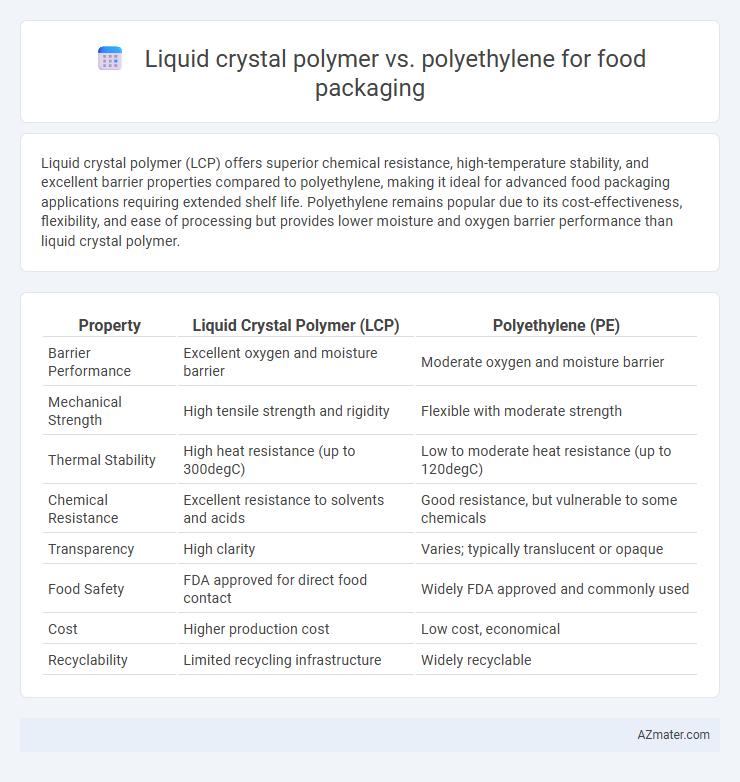Liquid crystal polymer (LCP) offers superior chemical resistance, high-temperature stability, and excellent barrier properties compared to polyethylene, making it ideal for advanced food packaging applications requiring extended shelf life. Polyethylene remains popular due to its cost-effectiveness, flexibility, and ease of processing but provides lower moisture and oxygen barrier performance than liquid crystal polymer.
Table of Comparison
| Property | Liquid Crystal Polymer (LCP) | Polyethylene (PE) |
|---|---|---|
| Barrier Performance | Excellent oxygen and moisture barrier | Moderate oxygen and moisture barrier |
| Mechanical Strength | High tensile strength and rigidity | Flexible with moderate strength |
| Thermal Stability | High heat resistance (up to 300degC) | Low to moderate heat resistance (up to 120degC) |
| Chemical Resistance | Excellent resistance to solvents and acids | Good resistance, but vulnerable to some chemicals |
| Transparency | High clarity | Varies; typically translucent or opaque |
| Food Safety | FDA approved for direct food contact | Widely FDA approved and commonly used |
| Cost | Higher production cost | Low cost, economical |
| Recyclability | Limited recycling infrastructure | Widely recyclable |
Introduction to Liquid Crystal Polymer and Polyethylene
Liquid Crystal Polymer (LCP) exhibits exceptional chemical resistance, thermal stability, and mechanical strength, making it ideal for advanced food packaging applications requiring durability and barrier properties. Polyethylene (PE), a widely-used thermoplastic polymer, offers excellent flexibility, moisture resistance, and cost-effectiveness, commonly employed in packaging for perishable food products. Both materials balance performance and functionality, with LCP often chosen for high-performance, specialized packaging, while PE serves as a versatile, everyday packaging solution.
Chemical Structure and Composition
Liquid crystal polymers (LCPs) feature rigid rod-like molecular chains with ordered crystalline structures, providing exceptional chemical resistance and barrier properties ideal for food packaging applications. In contrast, polyethylene (PE) consists of long, flexible hydrocarbon chains with a semicrystalline structure, offering good moisture resistance but lower barrier performance against gases and aromas. The aromatic rings in LCPs contribute to their thermal stability and mechanical strength, whereas polyethylene's simpler hydrocarbon makeup results in greater flexibility and ease of processing.
Barrier Properties: Oxygen and Moisture Resistance
Liquid crystal polymers (LCPs) exhibit superior barrier properties against oxygen and moisture compared to polyethylene, making them highly effective for food packaging applications requiring extended shelf life. LCPs' tightly packed molecular structure significantly reduces permeability, preventing oxidation and moisture infiltration that can degrade food quality. Polyethylene, while cost-effective and widely used, offers lower oxygen and moisture resistance, often necessitating additional barrier layers or coatings to achieve similar protective performance.
Mechanical Strength and Durability
Liquid crystal polymers (LCPs) exhibit superior mechanical strength and durability compared to polyethylene, making them ideal for high-performance food packaging applications that require resistance to wear and deformation. LCPs maintain structural integrity under extreme temperatures and stress, enhancing the shelf life and protection of packaged food. Polyethylene offers moderate durability and flexibility but lacks the advanced mechanical properties that LCPs provide, limiting its use in demanding packaging environments.
Thermal Stability and Temperature Resistance
Liquid crystal polymers (LCPs) exhibit superior thermal stability and temperature resistance compared to polyethylene (PE), maintaining structural integrity at temperatures exceeding 260degC, while polyethylene typically softens around 120degC. LCPs' high melting points and low thermal expansion coefficients make them ideal for high-temperature food packaging applications requiring sterilization or baking processes. Polyethylene offers adequate performance for low to moderate temperature conditions but lacks the thermal resilience needed for advanced food packaging systems exposed to elevated heat.
Flexibility and Processability
Liquid crystal polymers (LCPs) offer exceptional dimensional stability and high tensile strength but exhibit lower flexibility compared to polyethylene (PE), making PE preferable for applications requiring greater pliability in food packaging. Polyethylene's superior processability enables easy extrusion and sealing at lower temperatures, ensuring efficient manufacturing and versatile packaging designs. LCPs require specialized high-temperature processing equipment, which increases production complexity and costs relative to the more straightforward processing of polyethylene.
Safety and Regulatory Compliance in Food Packaging
Liquid crystal polymers (LCPs) exhibit exceptional chemical resistance and low permeability, making them highly suitable for safe food packaging applications by preventing contamination and maintaining food integrity. Polyethylene (PE), widely used in food packaging, meets FDA and EFSA regulatory standards for food contact materials due to its inert nature and proven safety profile. Both materials require adherence to specific migration limits and testing protocols to ensure compliance with global food safety regulations, including FDA 21 CFR and EU Regulation 10/2011.
Environmental Impact and Recyclability
Liquid crystal polymer (LCP) offers superior barrier properties and thermal stability compared to polyethylene (PE), but its environmental impact is higher due to complex manufacturing and limited recycling infrastructure. Polyethylene, widely used in food packaging, is more easily recyclable and has a lower carbon footprint throughout its lifecycle, promoting a circular economy. Innovations in biodegradable polyethylene and advances in chemical recycling could further reduce environmental burdens associated with traditional plastic packaging.
Cost Analysis and Economic Feasibility
Liquid crystal polymers (LCPs) exhibit superior barrier properties and thermal stability compared to polyethylene (PE), but their high raw material and processing costs significantly raise overall expenses in food packaging applications. Polyethylene remains economically feasible due to its low production costs, widespread availability, and ease of processing, making it the preferred choice for large-scale, cost-sensitive packaging solutions. However, for specialized applications requiring enhanced mechanical strength and chemical resistance, the higher investment in LCPs may be justified by improved shelf life and product preservation, potentially offsetting initial costs over time.
Future Trends in Food Packaging Materials
Liquid crystal polymers (LCPs) offer exceptional barrier properties, thermal stability, and chemical resistance, making them increasingly attractive for advanced food packaging applications compared to traditional polyethylene (PE). Future trends emphasize sustainable, high-performance materials like LCPs that enhance shelf life while enabling thinner, lightweight packaging with reduced environmental impact. Innovations in bio-based LCPs and recyclable composites are driving the shift toward eco-friendly, functional packaging solutions that meet stringent food safety and sustainability standards.

Infographic: Liquid crystal polymer vs Polyethylene for Food Packaging
 azmater.com
azmater.com